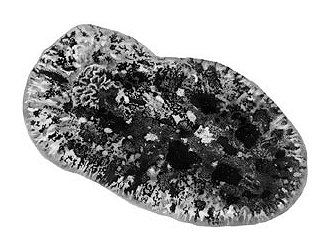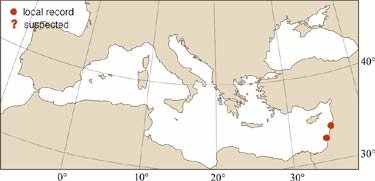
|
Relevant Synonyms
Misidentification*
* Records of Discodoris fragilis (currently regarded as a synonym of D. lilacina) in NE Atlantic and Western Mediterranean belong in fact to the similar species D. confusa Ballesteros et al., 1985. |
|
| drawing: Tuvia Kurz |
|
SHORT
DESCRIPTION
color :
animal pale greyish brown in overall appearance, with several rounded or oval dark brown spots of different sizes, being larger in the central region of the dorsum. Sometimes, two white patches in the dorsal midline, but obscured in heavily pigmented specimens. Along the innermost sides of the mantle margin, two lines of large, oval, black spots. The ventral side of the foot and mantle margin are covered with numerous brownish spots of various sizes.
common size :
adult usually reach up to 60-70 mm in length. |
DISTINGUISHING CHARACTERISTICS
BIOLOGY / ECOLOGY
habitat :
intertidal or shallow water in the Indo-Pacific, usually under dead coral slabs. The specimen recorded in Israel was dredged 40 m deep; the specimen from Lebanon found in rocky bottom at 2-3 m depth. |
|
1st
Mediterranean record
|

|
|
DISTRIBUTION
|
ESTABLISHMENT SUCCESS
speculated reasons for success :
|
|
|
MODE OF
INTRODUCTION |
IMPORTANCE TO
HUMANS |
|
KEY
REFERENCES
|
|
|
 Discodoris fragilis (Alder and Hancock, 1864)
Discodoris fragilis (Alder and Hancock, 1864)